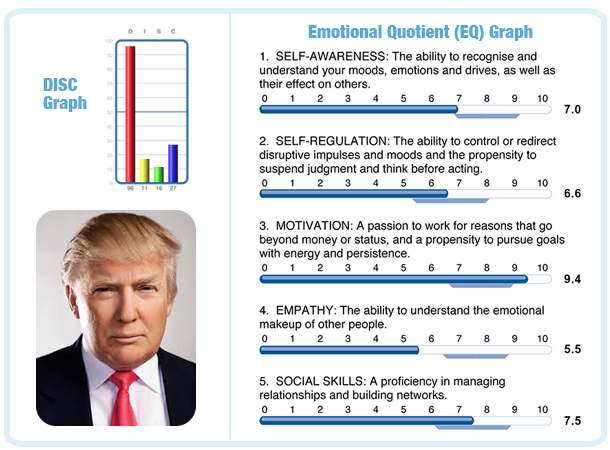How can studying DISC and EQ Explain How We Behave?
Our partners at TTI Success Insights recently shared some fascinating information regarding Donald Trump’s behavior, and how it can be better understood using DISC and EQ assessments. The entire article can be found on their Website, but we have included it in its entirety here:
Donald Trump: A case study in DISC and EQ – TTI Success Insights
Humans Are Complex Puzzles, With Many Facets
When it comes to the DISC assessment, there are few better examples of a “core” dominance (D) style than The Donald.
People with a high D behavioral style are often described as:
- Assertive
- Competitive
- Direct
- Decisive
- Challenging
- Pioneering
Clearly, Donald Trump ticks all the boxes for D tendencies.
But, then again, a lot of people tick all the boxes for D tendencies — yet, they aren’t as fiercely disliked as Trump.
Two people can share the same DISC pattern and yet come across as completely different people. Consultants who are trained in DISC — and only in DISC — may find this puzzling.
How could this be? What accounts for this difference? Enter emotional intelligence (EQ).
EQ is vital to understand, because it forms the basis of social effectiveness and has the power to bring out the best (and worst) traits in our behavioral (DISC) style.
It’s a broad term for a sophisticated skill set that, like leadership or creativity, is considered to be very important but rather difficult to define.

Let’s look at the EQ of The Donald.
Trump appears to be highly driven, so naturally we would give him a very high score in motivation.
Self-awareness and self-regulation, on the other hand, we would argue are somewhat lower. Empathy: a lot lower. Social skills are more difficult to pin down, so let’s explore this area further.
Many recent comments by Trump have exposed vulnerabilities in his social skills, suggesting a repeated tendency to miscommunicate, confuse the American public and unintentionally damage important relationships.
Evidence for this conclusion includes (but is not limited to) Trump’s recent remarks about:
- Mexican immigrants, which led to him losing key endorsements and sponsorships
- The suggestion that Sen. John McCain was not a war hero, which angered many within his own ranks
- The “blood coming out of her wherever” insult toward Fox News host Megyn Kelly
Trump later clarified he meant Kelly’s nose and ears, denying he implied Kelly was menstruating. He added, “I think only a degenerate would think that I would have meant that” — a comment that was notably clarified by The Tonight Show host Jimmy Fallon.
Social skills are underpinned by the other four pillars of EQ.
Self-awareness and self-regulation — that is, being aware of, and in control of your moods — are essential to good communication. As the saying goes, “Speak when you are angry and you’ll make the best speech you’ll ever regret.”
The emotion commonly associated with the D style is anger; however, there is a big difference between a high D with high self-regulation and a high D with low self-regulation.
This is something that troubles many about Trump as a genuine presidential contender: When his ego is rattled, he comes out swinging.
Many coaches and consultants we meet are asked to work with business executives who share the same DISC and EQ patterns as Trump.
The mistake we see too frequently from these consultants is only acquiring behavioral (DISC) information. Without going deeper than DISC, the consultant won’t be able to recognize the real issues at play. It’s like a doctor who lacks the proper diagnostic equipment to help his patients.
Humans are complex puzzles, with many facets.
Trump, like all people, is a case study in that complexity, capable of saying highly intelligent, pleasing, common sense things, and minutes later infuriating millions by making a clumsy and insensitive outburst.
Whether you agree with the EQ analysis of The Donald, the point is there is more to understanding the human condition than just learning about one’s behaviors (DISC).
Ultimately, consultants and coaches are beginning to recognize the need to move beyond just focusing narrowly on someone’s behavioral profile and toward building a more complete picture with the use of multiple assessments.
Editorial Credit of Featured Image: Albert H. Teich / Shutterstock.com

